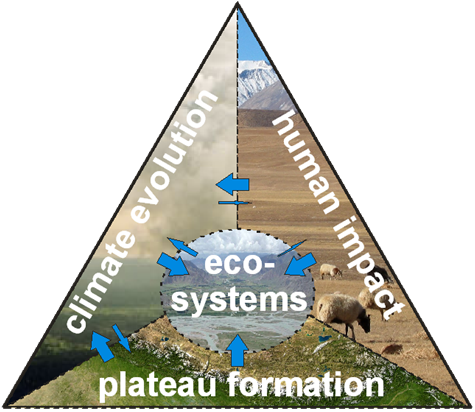Dynamic response of glaciers on the Tibetan Plateau to climate change
DFG SCHN 680/3-1/2/3, SCHE 750/4-1/2/3, BU 949/20-1/2/3 (SPP 1372)
From 07/2008 to 10/2014Principal Investigator: Dieter Scherer, Christoph Schneider, Manfred Buchroithner, Tandong Yao
Staff: Tobias Bolch, Fabien Maussion, Eva Huintjes, Tino Pieczonka, Marinka Spieß
Like Antarctica and the Arctic, the Tibetan Plateau (TiP) is a key area of the globe. Its formation had a profound impact on the environmental evolution at regional and global scales and until today directly influences the habitat of billions of people. It is a determining factor for the Asian Monsoon system and provides water resources of cardinal importance for both ecosystems and local population.
Within a large consortium of Chinese and German research teams, the TU Berlin, in association with the TU Dresden and the RWTH Aachen will focus on the Glaciers evolution and response in the last decades. A major part of Asia’s water supply is dependent on the hydrological cycle related to the plateau, and human impacts on it may have far reaching consequences. Moreover, the Tibetan plateau, like the Polar Regions, proves to be particularly sensitive to anthropogenic Global Change.
The central goal of the research is to improve our understanding of atmosphere-cryosphere interactions on the TiP by adding new data and improved methods on short- and long-term variations in energy and mass balance components due to large-scale atmospheric forcing, including variations and shifts in glacier dynamics induced by climate change. Until now field studies and remote sensing data analyses focused on glaciers in the Nyainqentanglha Mountains near Nam Co, where the Institute of Tibetan Plateau Research (ITP) of the Chinese Academy of Sciences (CAS) operates a research station. Additionally, special attention in the future is given to transfer glacier models, processing chains of remote sensing data and provision of modelled atmospheric data to glacier locations along a west-east transect across the TiP.
The field measurements carried out by the ITP will be supplemented by our own field measurements and analysis of remote sensing data. Based on these data we will develop and test an optimised numerical model framework for computing surface energy and mass balance components on selected glaciers on the TiP with varying influence of Indian Monsoon and Westerlies to estimate their future dynamic response on climate change.
List of publications of this Project
| Maussion, F; Scherer, D; Finkelnburg, R; Richters, J; Yang, W; Yao, T: WRF simulation of a precipitation event over the Tibetan Plateau, China – an assessment using remote sensing and ground observations, Hydrology and Earth System Sciences, 15, 1795-1817 (2011), doi:10.5194/hess-15-1795-2011, 2011 [Link] -- Details |
| Bolch, T; Yao, T; Kang, S; Buchroithner, M; Scherer, D; Huintjes, E; Schneider, C: A glacier inventory for the western Nyainqentanglha Range and Nam Co Basin, Tibet, and glacier changes 1976-2009, The Cryosphere, 4, 419-433 (2010) |
Related links:
- Experiment: Nam Co and Zhadang Glacier 2009-2014: Dynamic response of glaciers on the Tibetan Plateau to climate change (DynRG-TiP)
- Field site: Nam Co: Nam Co Basin
- Field site: Zhadang: Zhadang Glacier

